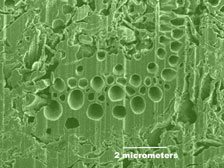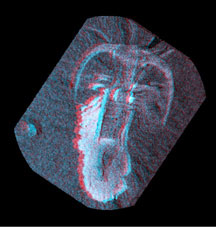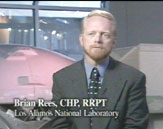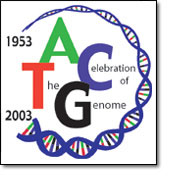Research
Highlights...
|
 |
| Number 130 |
April 14, 2003 |
|
Diatomite dilemma: Getting at the oil
 |
|
Nanoscale
image of diatomite
|
Consisting of silica skeletons of microscopic aquatic plants, oil-bearing
diatomite is fragile—up to 70 percent empty space—but
nearly impermeable. Using ion-beam milling and imaging, Liviu
Tomutsa of the Earth Sciences Division and Velimir Radmilovic
of the National Center for Electron Microscopy at Lawrence
Berkeley National Laboratory have made nanoscale images of
diatomite. "As the beam shaves off layers of material a few nanometers
thick, it simultaneously makes a stack of 2-D images," says Tomutsa.
From these they will build a 3-D picture that reveals the constrictions
and connectivity of the pores, factors that affect trapping of
liquids.
[Paul Preuss, 510/486-6249,
paul_preuss@lbl.gov]
|
|
What chemicals are
in our air?
DOE's Pacific Northwest National Laboratory
has created a Chemical Testing Chamber to identify harmful chemicals
in the air as well as test the performance of sensors used to
detect weapons of mass destruction. The chamber includes a powerful
new gas chromatograph-mass spectrometer, which can be used to
identify concentrations of any one of thousands of organic chemicals.
The facility is different from other chemical testing chambers
in that it gives scientists the capability to work with the very
low concentrations of semi-volatile chemicals. Semi-volatile chemicals
are used to produce pesticides and herbicides, but also can be
used in chemical weapons made by terrorists. The chamber is undergoing
final performance testing and will be ready for research use later
this spring.
[Ginny
Sliman, 509/375-4372,
Virginia.sliman@pnl.gov]
|
|
Agriculture for the
future
A team of Idaho National Engineering
and Environmental Laboratory and Oak
Ridge National Laboratory scientists are conducting discussions
with agricultural interests to create an R&D roadmap. The roadmap
aims to produce feedstock
for future biomass refineries. Through new agribusiness, a sustainable
supply of biomass would be available to produce clean fuels and
chemicals from corn and wheat stalks and the substance that cements
cell walls together. The goal of this DOE Office of Biomass
project is to move the U.S. towards energy independence, and
guide the allocation of limited funds to national labs and universities
that can make the project successful. Discussions are being held
in Washington, D.C., Chicago, Minneapolis, Boise and Oklahoma City.
[Reuel
Smith, 208/526-3733,
mrs@inel.gov]
|
|
X-rays produce fossil
images in stereo
 |
|
650-million-year-old
Marella splendens fossil
|
Scientists at DOE's Los Alamos
National Laboratory, working with researchers from Conoco-Phillips,
have demonstrated the ability to generate elemental X-ray images
using micro X-ray fluorescence. The team recently obtained stereoview
elemental images of a 650-million-year-old Marella splendens
fossil from the Burgess shale in Canada (see accompanying image).
Researchers exposed the fossil-bearing rock to an X-ray beam and
captured the resulting fluorescence, or X-ray emission, in the
form of spectral lines, to image the fossil. The stereoview image
shows dimensional elemental features that cannot be seen by eye.
The process will be useful to a wide array of other difficult
material analyses.
[Todd
Hanson, 505/665-2085,
tahanson@lanl.gov]
|
|
JGI marks genomics
milestones
The role of DOE's Office of Science
in genomics research is being highlighted this month as two of the
most important landmarks in the history of biological research are
celebrated: the completion this year of the human genome sequence,
and James Watson and Francis Crick's Nobel Prize-winning description
of the DNA double helix 50 years ago. The DOE Joint
Genome Institute (JGI) in Walnut Creek, California, played a
key role in the Human Genome Project
by sequencing chromosomes 5, 16 and 19. The JGI is a consortium
formed by Lawrence Berkeley, Lawrence
Livermore, and Los Alamos
national laboratories.
[Charles
A. Osolin, 925/296-5643,
osolin1@llnl.gov]
|
|
Fighting
radiological terrorism
with knowledge
 |
|
Brian
Rees
|
Across the United States, medical and hospital professionals
are learning about the effects of nuclear exposure and radiation
dispersal devices (RDDs) thanks to the on-camera skills of Los
Alamos health physicist Brian Rees.
Radiological Terrorism for Healthcare is an educational
video made to inform health professionals of the reasonable
precautions that are effective in treating those exposed to
RDDs and other sources of nuclear contamination.
 |
|
Radiological
Terrorism
for Healthcare
|
The Tucson, AZ-based Medfilms
company that produced the tape contacted DOE's Los
Alamos National Laboratory in 2002 to see if anyone there
could talk about the effects of an RDD, in the logical, down-to-earth
terms that would be helpful to nurses and other emergency workers.
Rees, already providing similar, live briefings as part of his
work with the Laboratory's Health, Safety, and Radiation Protection
Division, was an easy choice.
"Medical personnel cover a wide gamut of the population in
general, and many of them have the same misconceptions about
radiation that the general population has," says Rees. "I wanted
to be sure their misconceptions didn't end up harming anybody,
either by their actions or inactions.
" With that in mind, Rees and the Medfilms director,
Alan Reeter, developed a video that shows, through the example
of a 1987 radiation-exposure incident in Goiania, Brazil, what
health-care workers can expect in a radiological accident or
deliberate exposure situation. Among the key effects is panic,
which brought over 100,000 people to hospital doorways in Goiania,
despite the fact that just over one percent of that number actually
required hospitalization—still a significant number, four
of whom died, but nowhere near as large as the surging crowd
that sought treatment and reassurance.
The video, already available to hospitals for several months
now, recently won a "Chris" award from the Columbus International
Film and Video Festival in Columbus, Ohio, in the Physical Health
category.
Submitted by DOE's Los
Alamos National Laboratory
|
|





